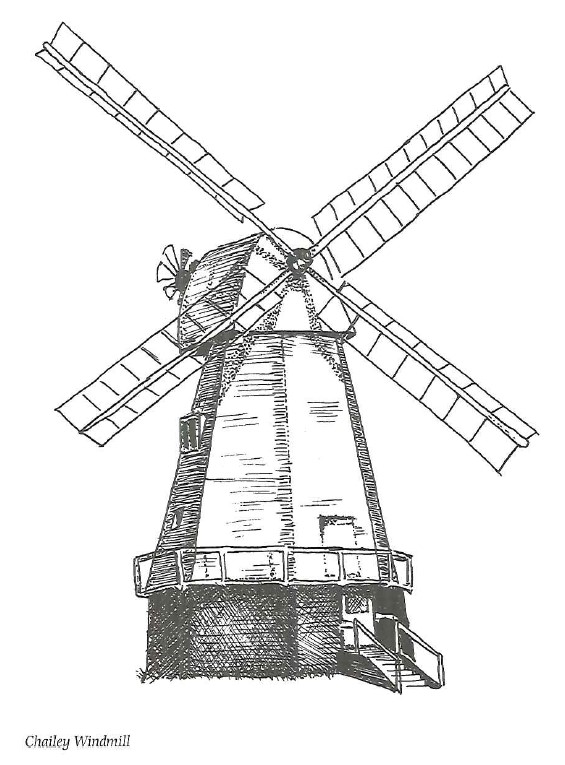It has something of the feel of a frontier town in the Wild West, on a smaller scale of course. Straddling the old turnpike road from East Grinstead to Lewes, its people used to eke out their livings on Ashdown Forest, which still stretches unkempt and sometimes forbidding up to the cottage gardens.
It was a rough and ready kind of place in the old days. The Sussex historian Mark Antony Lower denounced forest dwellers as ‘rogues and vagabonds … the locality was infamous … for the deeds of poachers, horse stealers and smugglers.’
When the fair visited Nutley, in the field by the old Shelley Arms, the stallholders always nailed their gingerbread to the counter for fear the foresty people’ would snatch the lot.
A unique record of the village’s past was made by Arthur Francis, known to everyone as ‘Daddy’, in a collection of photographs taken at the turn of the century, not only portraits of people but of the buildings and local activities, building-up a panoramic picture of the parish. There were many more forest dwellings than there are now and also industries which have disappeared like hop growing and brick making.
The writer Barbara Willard, who made her home in the village, recorded before the Second World War there were ‘strange ragged characters under rough shelters, barefooted children, bearded tinkers. There was great poverty and loneliness, even so short a time ago. The road was small, dusty and winding; and at the pub on the corner, one that has now gone, the landlord would give you a pint of beer just to stay and talk to him.’
Pinching bits of the forest was considered a perfectly respectable occupation (by some) until late in the 19th century and there was none more adept than James Tinker’ Wright, a man partial to chewing a mixture of tobacco and Spanish licorice kept in a coffin-shaped tin box of his own construction. He squatted on the forest and from time to time enclosed an acre of ground and built a hut upon it. This he afterwards sold and bought, legitimately, a much smaller enclosure where another matchboard mansion’ sprang up to become home to his wife, three sons and grandchild – with a donkey underneath them – all for the princely sum of 10 shillings.
The Sanitary Inspector one day reported it to the District Council as not having sufficient cubic feet of air for the inhabitants but, as one member of the council remarked: “You
might just as well talk of the cubic contents of a birdcage.’
One winter’s day Tinker himself told the Rev Harry John Peckham, vicar of Nutley from 1882 to 1913: “You would have laughed if you had been in my place this morning. I always sleep in an old billcock hat, and this morning when I woke, bothered if my head wasn’t jammed tight. It had snowed in the night and come through the cracks, and my head and my hat and the wall was all froze together solid, and I was forced to tear the old hat before I could get my head out.’ Mrs Peckham knitted him a balaclava to replace the spoilt billycock.
Today’s residents are more affluent and the sense of pride they have in their village is reflected in the hassocks in the church, made by the locals and all beautifully decorated, some with forest themes.
Nutley has always been renowned for the prowess of its stoolball teams, the game said to have been invented by milkmaids using their milking stools as bats that Sussex has made her own, and for its formidable tug-of-war team.
It has also become something of a mecca for Red Indian enthusiasts, people whose interest in the North American tribes extends to wearing eagle feather bonnets, buckskin, beads and moccasins; setting up teepees and singing and dancing in true redskin style.
A Wellington bomber crashed near here in July 1941 after a raid over Germany. A memorial to Sgt Pilot Victor Ronald Sutton was erected at the site, now given a wall made of local stone. It is known locally as the ‘airmen’s grave’ though none of the plane’s crew is actually buried here. The inscription reads: “To the glorious memory of Sgt/P. V.R. Sutton, aged 24 years, 142 Bom. Sqdn. RAF also his five comrades who lost their lives through enemy action 31-7-41. Mother.” Every Remembrance Sunday the Conservators of Ashdown Forest are among those who lay a wreath at the site.
Nutley’s wooden windmill, the open trestle post variety, ceased its commercial life in 1908 but has been lovingly restored by members of the Uckfield and District Preservation Society for which they gained a European Architectural Heritage Year Award in 1975. Today it is claimed to be the oldest working windmill in Sussex.
It is to the forest that the village owes the local legend of the headless ghost. A smuggler had his head shot off in a fight with the preventive men and his spirit wanders the lonely hills and valleys with a lantern, supposedly searching for the spot where he hid his kegs of brandy before coming to such an unfortunate end at the hands of the King’s men.
